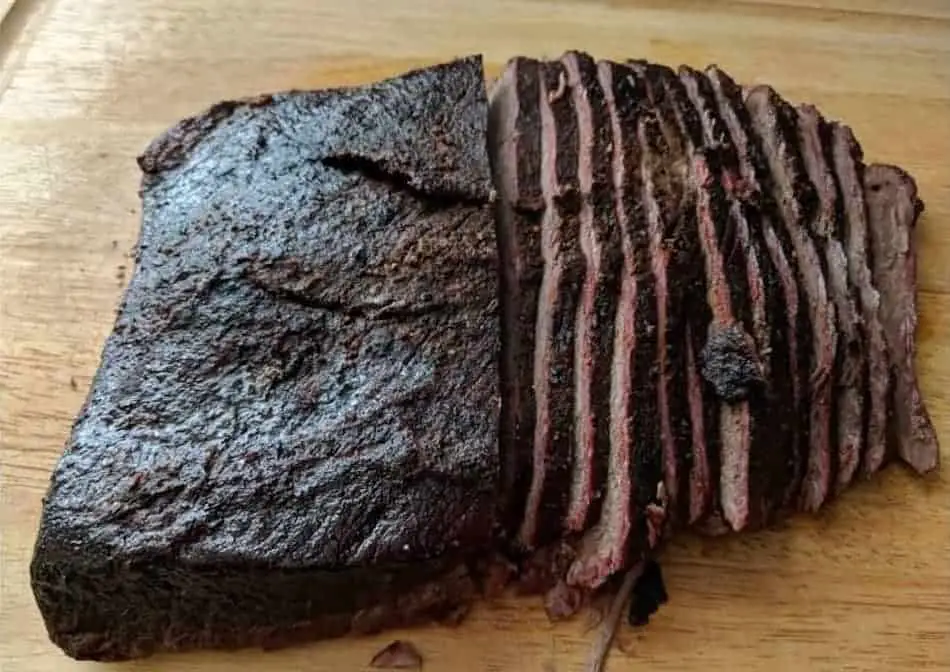
There’s nothing more frustrating than spending hours smoking meat only for it to turn out dry. Meat smoking is a labor of love, so you want to get it right. I wanted to find out how to get tender, juicy meat every time, so I did some research and found out how to avoid dry meat every time you fire up the smoker.
One of the most common reasons that smoked meat can become dry is due to high cooking temperatures. If the meat is exposed to high heat for an extended period of time, much of the moisture will be drawn out and the meat will become dry. To prevent this, it’s important to smoke the meat at low and slow temperatures, typically in the 200°F to 250°F range. This will help the meat retain its juices and become more tender. Another important factor to consider is the resting time after cooking. After the meat is removed from the smoker, it should be allowed to rest for at least an hour to allow for moisture reabsorption. This will help to make the meat more tender and juicy. There are also a few techniques that can be used to help prevent the meat from drying out during the cooking process. Dry brining with salt prior to smoking will help the meat retain moisture, and techniques like marinading, injecting, mopping, and foiling can also help replace lost liquid.
10 Ways To Avoid Dry Smoked Meat
| Method | Description |
|---|---|
| Cook at low temperatures (220°F to 250°F) | Cooking at lower temperatures will help retain moisture in the meat. |
| Use decent thermometers | Using thermometers will help you monitor the temperature of your smoker and the meat to ensure it is cooking at the proper temperature. |
| Use a water pan in your smoker | Adding a water pan to your smoker will help to create a moist environment and keep the meat from drying out. |
| Brine the meat | Brining the meat before smoking it will help it retain moisture during the cooking process. |
| Wrap the meat in foil | Wrapping the meat in foil will create steam, which can help keep it moist. |
| Allow adequate resting time | Allowing the meat to rest after it is cooked will give it time to reabsorb moisture and become more tender. |
| Marinade the meat | Marinating the meat will add extra moisture to it. |
| Mop/spritz the meat | Moping or spritzing the meat with liquid while it is cooking can help keep it moist. |
| Inject the meat with liquid | Injecting the meat with liquid will add moisture and flavor. |
| Buy meat with good marbling | Meat with good marbling (fat content) will help it retain moisture during the cooking process. |
Why is My Smoked Meat Dry?
If the temperature of your smoker is too high (above 250°F), your meat is at risk of drying out because the high heat will cause the moisture to escape. The other possibility is the meat was not given adequate time to rest before slicing. Meat needs at least 1 hour to rest after being removed from the smoker, because if it’s sliced too soon, all the juices will spill out over the cutting board. The resting period allows the meat to reabsorb moisture, making the meat tender and juicy.
The Science Behind Dry Meat
The liquid found in meat is actually water, not blood. The muscle fibres inside the meat help retain moisture and determine how much fluid is expelled. So the more liquid that gets squeezed out of the muscle fibres, the dryer the meat will become. This process of fluid loss is the result of chemical reactions that go on inside the muscle fibres. High temperatures are what will influence these chemical reactions. If the temperature is too high while cooking, various chemical reactions will occur inside the muscle fibres and result in fluid loss. Significant loss of moisture occurs after the internal meat temperature reaches 150°F. It is for this reason, temperature control at the various stages of smoking is critical.
1. Control The Temperature
Controlling the temperature of your smoker is the best way to prevent your meat from drying out, but some smokers are harder to control than others. Pellet grills, gas smokers and electric smokers are set-and-forget, whereas charcoal smokers and offset smokers are unpredictable and influenced by external forces. If you don’t know how to control the fire, you will have huge temperature fluctuations which will put your meat at risk.
Don’t Open The Lid
Constantly opening the lid is one of the biggest mistakes you can make because it will increase airflow in your smoker and raise the temperature and dry out your meat. Try to keep opening the lid to a minimum and do everything all at once to minimize the amount of times you need to remove the lid. Move as fast as you can when opening the lid, quickly mop your meat, fill the water tray and put the lid back on.
Control The Vents
Learning how to adjust the vents on your smoker is the key to good temperature control. It might be worth doing a practice run on your smoker before you go out and buy a nice expensive cut of meat. Practice on inexpensive cuts of meat, or do a fire up a dry run without meat. Keep a smoking journal and record the temperature changes, the weather, the amount of fuel you used and all the vent adjustments.
Weather Can Ruin Your Meat
The weather can also influence the temperature of your smoker. If it’s a windy day, the airflow will increase and cause the temperature to spike, and ruin your meat. Protect your smoker from the wind by positioning it next to a wall. If it’s a cold day, you may need to use extra fuel or open the vent to increase the temperature. On a hot day, you may have to move the smoker into a shady area.
Drop The Temperature Of Your Smoker
Vent control is the primary way of managing your smoker, however, if your smoker is running too hot, you may have to remove some of the fuel. Making the fire smaller will lower the temperature significantly. To remove charcoal, use a pair of long metal tongs and pick out some coal until the fire is manageable.
2. Buy A Good Thermometer
You can’t smoke tender, juicy meat unless you own a good remote ‘leave-in’ thermometer. A meat thermometer is a vital tool and will be your best friend while smoking meat. If you want tender, juicy meat, you need to know what’s going on inside your meat, and the only way to track the internal meat temperature is by leaving a thermometer probe in your roast. Traditional roasting teaches us to cook to time, but low-and-slow roasting is all about cooking to a target internal temperature. For example, the perfect brisket is cooked to an internal temperature of 203°F. Any higher, the meat will be dry.
Many smokers come with built-in thermometers, but these aren’t trustworthy. Invest in a good thermometer so you can track your meat with precision. You don’t have to spend a lot of money on thermometers, there are some affordable models that are accurate and reliable. Check out The Best Meat Thermometers Under $50 and The Beginner’s Guide To Meat Thermometers.

3. Use a Water Pan
If your smoker runs too hot, it’s important to place a water pan inside the smoker to help absorb some heat and regulate the temperature. The water will increase the humidity and help keep the meat moist. Place a water pan in the middle of the cooking section on the lowest rack and refill with hot water every 3 to 4 hours. Use cold water if the smoker is running too hot.
4. Brining
Brining is another way to ensure your meat doesn’t turn out dry. The salt in a brine will not only add extra flavor, but it will help the meat retain moisture while it’s cooking. There are two ways of brining; a wet brine or a dry brine.
Dry brining is by far the easiest way to brine meat. All you need to do is rub kosher salt into the meat and leave it in the refrigerator overnight. The salt will penetrate the meat and during the long cook, will hold in moisture, preventing the meat from drying out.
A wet brine is a salt and water solution that can add extra flavor and moisture to the meat. Soaking the meat in a brine will also increase your chances of getting a nice smoke ring on the outside layer of the meat. Soak the meat in a brine several hours before smoking by using a large zip-lock bag or container. For more on brining, check out Should I Brine a Brisket?
5. Mopping & Spritzing
Mopping or spritzing the meat is another way to keep the meat moist and prevent it from drying out. Wetting the meat at regular intervals will add moisture to the cooking chamber, and some believe it helps replace lost liquid from the meat. Mopping involves brushing the meat with a miniature mop and bucket. The mop sauce is usually combinations of oil, fat, water, vinegar, apple cider, beer or tomato juice. Spritzing is simply spraying the meat with a spray bottle.
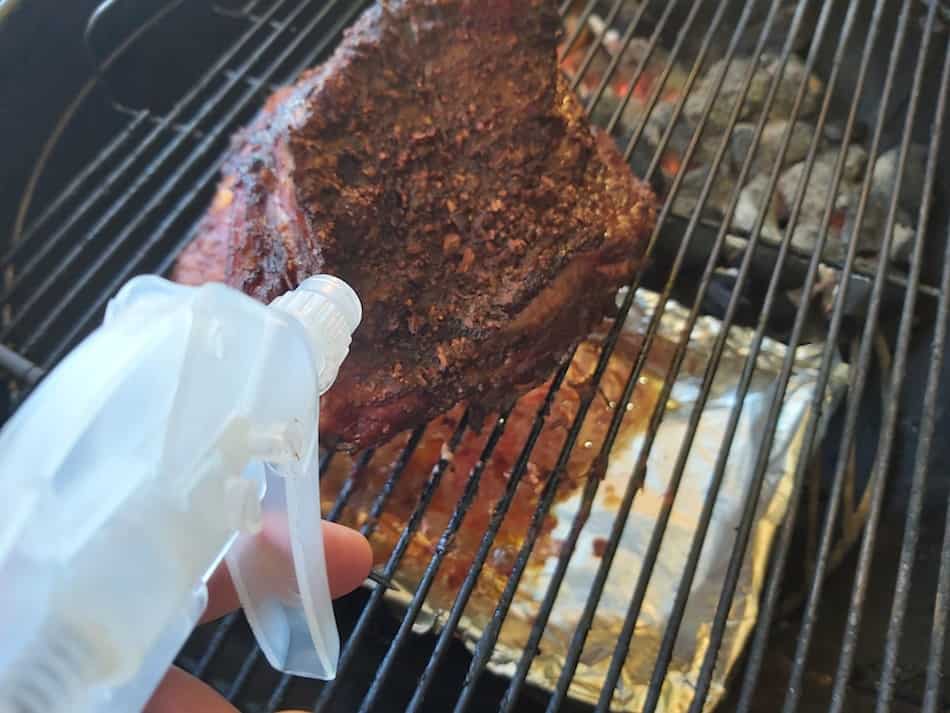
6. Marinading
Soaking the meat in a marinade can help keep the meat moist during the smoking process. Find a good recipe and soak the meat in a casserole dish and leave in the refrigerator for 12 to 24 hours prior to smoking. Marinades work well with smaller cuts of meat like chicken wings but won’t do much for larger, tougher cuts of meat like brisket. With brisket, for example, all a marinade will do is add some flavor and moisture to the outer layer. The only way to penetrate the surface would be to inject the marinade into the meat, like they do in barbeque competitions.
7. Wrapping
Another way to avoid dryness is to wrap the meat in foil at different stages. Wrapping the meat in foil creates steam, which adds moisture. The first few hours of the smoke is when the meat will absorb the beautiful smokey flavors, so you’ll want to avoid wrapping in the early stages. In the last few hours of the smoke, the meat will have already developed a hard crust, so it won’t absorb any more of the smoke flavor. It is at this stage where you can wrap the meat in foil. Wrapping the meat is a good way of maintaining moisture but remove it for the last hour or so to harden the crust prior to serving. There are a few different wrapping methods, so if you want to learn more, check out What Should I Wrap My Brisket In?
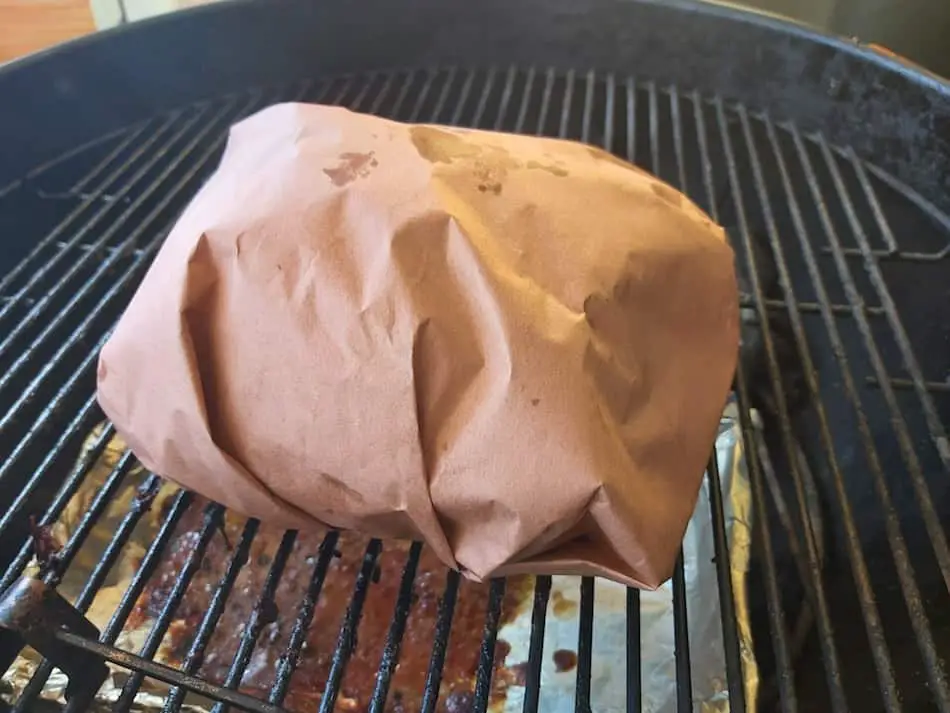
8. Resting
One of the main reasons meat turns out dry is not allowing the meat enough time to rest. If you carve the meat as soon as you take it out of the smoker, all the juices will spill out and the meat will taste dry. Resting for about 15-30 minutes will allow the meat to reabsorb the lost moisture. Brisket is commonly rested for 1-hour and wrapped in a towel and stored in a dry cooler. For more on resting, read How Long Should I Rest Brisket?
9. Marbling
Always buy the best meat you can afford, because quality meat with good marbling will be far more tender and juicy. Marbling is the fatty striations, or fat between the muscle. If a cut of meat has no marbling, it will look like red flesh without fat. A marbling score of 3 is the lowest and 13 is the highest marbling score. Cheaper cuts of meat will have little marbling and more expensive cuts such as Wagyu will have a marbling score of 13.
Often we can do everything else right, manage the temperature of our smoker, wrap, spritz, but still the meat isn’t tender and juicy. If you buy poor quality meat, all the techniques in the world won’t make all the difference. For more on how to select meat with good marbling, check out Marbling on Brisket.
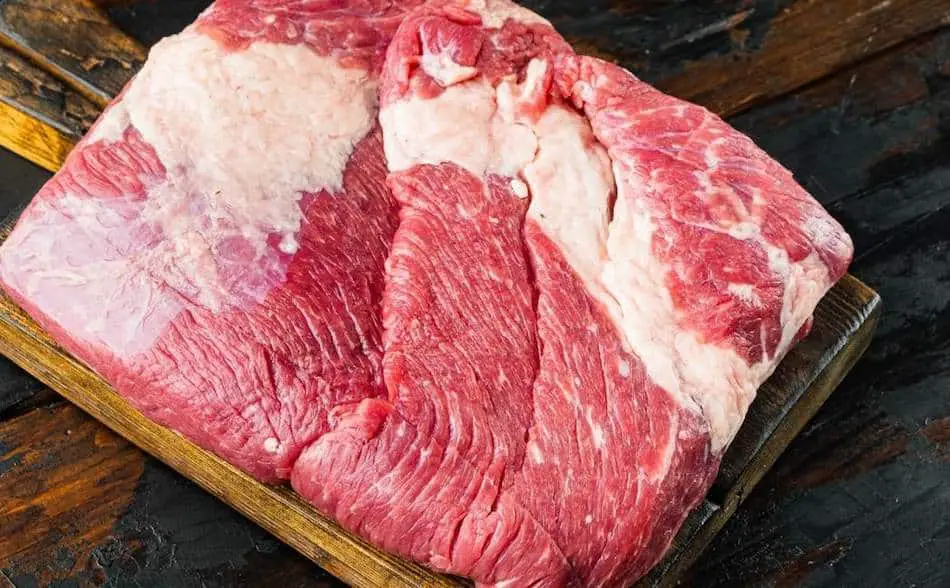
10. Injecting
Another way to add extra moisture into the meat is through injection. Large roasts like brisket need some added fluid because they lose so much moisture over the long cook. The most common liquids used to inject meat are broth, marinades, butter, beer, apple cider vinegar or apple juice. Meat injectors are simple to use and affordable, depending on the quality. Amazon sells a variety of meat injectors in different styles such as trigger injectors, stainless steel syringes or cheap plastic injectors. For an in-depth look at meat injection, check out Should I Inject Brisket?
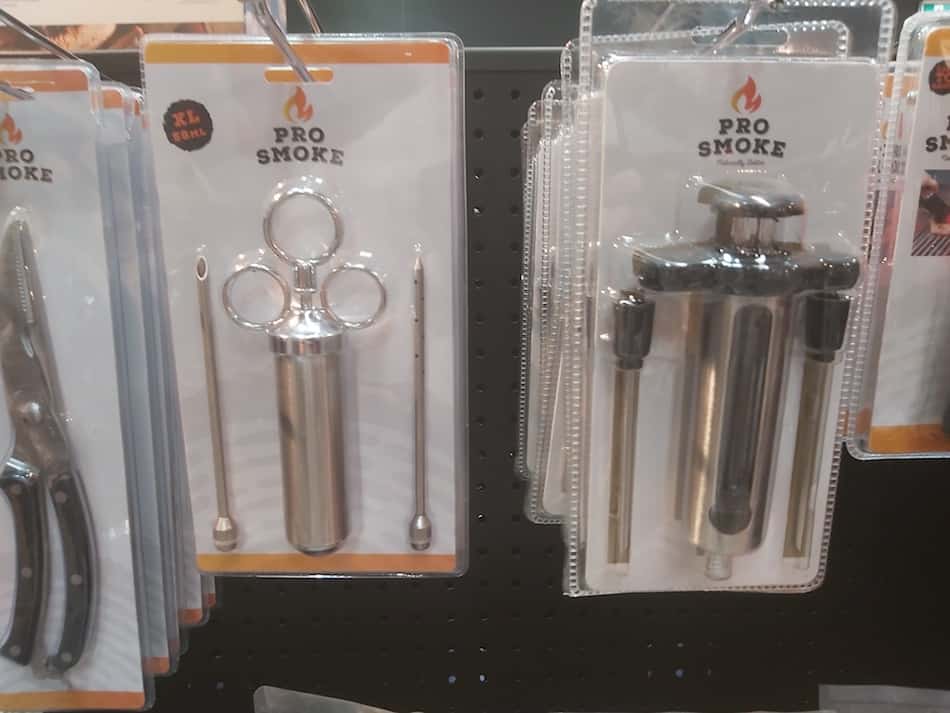
My Favorite Meat Smoking Tools
Thanks for checking out this article. I hope you learned a few things. Here are some of my favorite tools I use when smoking brisket that may be useful to you. These are affiliate links, so if you decide to purchase any of these products, I’ll earn a commission. But in all honesty, these are the tools I recommend to my family and friends who are just starting out.
Meat Thermometer: There are dozens of fancy thermometers on the market, but I still use my trusty TP20. For around $50, I have a high-quality meat thermometer with two probes, and can track the temperature of my smoker with one probe, and my meat with the other probe. The ThermoPro TP20 is an Amazon Best Seller because it’s the easiest thermometer to operate, is durable, highly accurate, and comes with pre-programmed meat settings.
Instant Read Thermometer: Arguably, the second most important tool you need is a fast and accurate instant-read thermometer. These tools play an important role in the latter stages of the cook when the meat needs regular checking in multiple areas. I use the ThermoPro TP19 because it can do everything a ThermaPen can do, but for a fraction of the cost. You can check out the TP19 on Amazon here.
Wireless Thermometer: The latest thermometers on the market have no wires and can be controlled by wi-fi via your phone. Airprobe 3 is the best of this technology.
Butcher Paper: Wrapping brisket in butcher paper has become a huge trend in barbeque thanks to Aaron Franklin. Wrapping your brisket in paper will give you a nice brisket bark. However, you can’t just use any old paper, it has to be unwaxed, food grade paper. You can find it on Amazon here.
Advanced Thermometer and Automatic Temperature Controller: Once you’re ready to take things seriously, the FireBoard 2 Drive is a six-channel Bluetooth/Wi-Fi thermometer that can monitor up to 6 pieces of meat, control and graph your cook sessions on your smartphone, and attaches to an an automatic blower that will convert your charcoal smoker to a set-and-forget. This is one of the most advanced meat thermometers on the market. You can check it out on the FireBoard website here.
Related:
Brisket For Beginners: Tips For Smoking The Perfect Brisket
